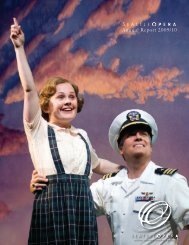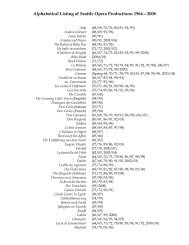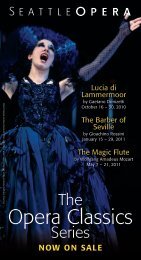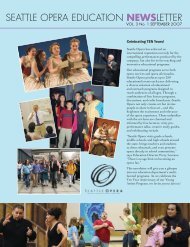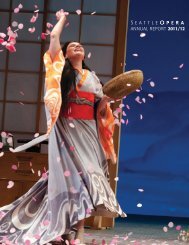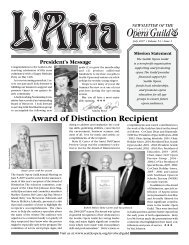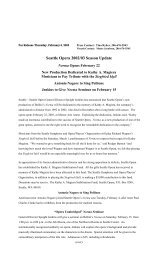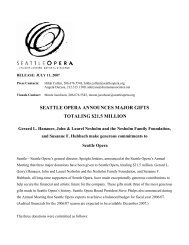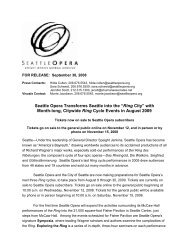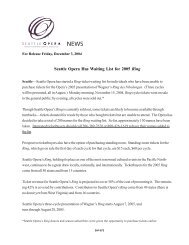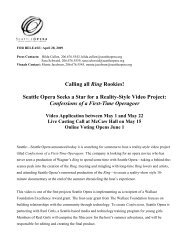Create successful ePaper yourself
Turn your PDF publications into a flip-book with our unique Google optimized e-Paper software.
Puccini Seeks<br />
New Adventures<br />
After the success of La bohème, Puccini was<br />
on top of the world. But by the time he wrote<br />
Madama Butterfly, eight years later, the musical<br />
intelligentsia, particularly hungry for novelty<br />
in those watershed days of “modern” music,<br />
were accusing him of resting on his laurels and<br />
repeating past successes. (It’s true that Butterfly<br />
first steps onstage to a slowed-down version of<br />
Musetta’s Waltz!) So following Butterfly, Puccini<br />
was indeed on the lookout for projects that<br />
would stretch him in new directions.<br />
In 1907, he was invited to New York to supervise<br />
performances of his operas at the Metropolitan<br />
<strong>Opera</strong>. Puccini ended up writing an opera for<br />
the Metropolitan: La fanciulla del West, a very<br />
American story about a plucky, can-do barmaid<br />
in a California mining town. During World War I,<br />
Puccini tried his hand at writing a Viennese-style<br />
operetta, La rondine, which premiered in Monte<br />
Carlo. And as the war ended, he put together Il<br />
trittico, a series of three one-act operas which<br />
also premiered at the Metropolitan. Together they<br />
form an almost Dantesque progression through<br />
hell, purgatory, and paradise; but because they<br />
make vast demands on an opera company, it’s<br />
rare nowadays to see all three on the same<br />
evening. Il tabarro is a gritty story of jealousy<br />
and murder among low-lifes, set on a barge on<br />
the Seine; Suor Angelica, one of the few operas<br />
to feature an all-female cast, contains some<br />
of Puccini’s most breathtaking, and certainly<br />
his most mystical, music; and Gianni Schicchi,<br />
his only comedy, rounds out this magnificent<br />
triptych with laughter and love.<br />
Puccini and His<br />
Suffering Women<br />
In Act III of Manon Lescaut, Puccini’s first operatic<br />
triumph, a parade of “undesirable women” (i.e.,<br />
prostitutes) are brought onstage one by one,<br />
publically humiliated by having their hair cut<br />
off, and then forced to board a ship headed for<br />
the new world—deported for their sins. In a way,<br />
this scene foreshadowed what Puccini was to do<br />
for the rest of his career. In opera after opera,<br />
he makes his audience cry by showing them the<br />
pathetic suffering of a beautiful woman whose<br />
only crime is love. In La bohème, Mimì dies of<br />
Top: In Madama Butterfly, Cio-Cio-San kills herself when Kate Pinkerton asks her to give up her child. Bottom:<br />
In Turandot, Liù kills herself so Turandot will give Calaf her love.<br />
tuberculosis, a disease associated with sinful<br />
lifestyles in the nineteenth-century imagination.<br />
Puccini heroines who kill themselves after<br />
psychological torture—and losing whomever they<br />
most love— include Tosca, Madama Butterfly, Suor<br />
Angelica, and Liù. Puccini was well aware of the<br />
sadistic streak to his creativity, and even made his<br />
peace with it. As he died of throat cancer, Puccini<br />
joked that the seven radium crystals inserted into<br />
his neck were the revenge of the seven sopranos<br />
who die in his operas.<br />
But it’s an oversimplification to think that all<br />
Puccini heroines are pathetic victims who endure<br />
heartless cruelty and then kill themselves. There’s<br />
another kind of woman in Puccini’s operas, an<br />
assertive, powerful goddess who knows what<br />
she wants and goes after it. She may be sympathetic,<br />
like Musetta in La bohème or Minnie in<br />
La fanciulla del West, or not, like the Princess in<br />
Suor Angelica; but she always stands tall among<br />
all the strong women you’re likely to encounter<br />
on the opera stage. Turandot, Puccini’s final<br />
masterpiece, features both archetypes in its<br />
fearsome princess and suicidal slave girl.<br />
These two characters are eerily reminiscent of<br />
two real women in Puccini’s life. An avid sports<br />
car enthusiast, Puccini was in a car accident in<br />
1903. He hired a live-in nurse to help him regain<br />
<strong>Seattle</strong> <strong>Opera</strong>, 2012, (Elise Bakketun photo)<br />
Turandot, Pittsburgh <strong>Opera</strong>, 2011 (David Bachman photo)<br />
32 2012/13 Season at <strong>Seattle</strong> <strong>Opera</strong>



